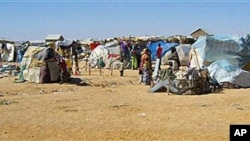Capping a three-day tour of refugee camps in drought-stricken parts of Somalia, U.N. Emergency Relief Coordinator Valerie Amos told reporters that serious international focus is needed to head off increasingly severe shortages of food and water.
“Somalia, as you know, hosts one of the largest populations of displaced people in the world and is again teetering on the brink of a much larger-scale disaster due to the threat of a country-wide drought," said Amos. "Malnutrition rates have increased in the last six months in Somalia.”
British-based aid group Oxfam International has warned that many areas in southern and central Somalia have received as little as 15 percent of their typical rainfall, with some areas receiving no rain at all. Amos added to Oxfam’s findings Thursday, telling reporters in Nairobi that as many as 2 million Somalis - more than 25 percent of the population - are facing starvation.
According to the United Nations, one in four children in Somalia are already acutely malnourished. The failure of the country’s short rains period - from October through December - has put even further strain on pastoralist communities. The widespread deaths of livestock, such as camels, have deprived many rural Somalis of access to such basic staples as milk. It is estimated that as many as 20,000 have been forced to leave their homes in search of pastures, food and water.
Compounding the problem is the Islamist insurgent group al-Shabab. The al-Qaida-linked group controls much of central and southern Somalia, including parts of Mogadishu, and has restricted access for humanitarian groups, including the United Nations. U.N. Humanitarian Coordinator Mark Bowden said the group would need to soften its stance to prevent famine from occurring.
“I know that there is continuing discussion within the Shabab," said Bowden. "I very much hope that as the situation deteriorates there will be an easing up of the position to recognize that a larger amount of assistance will be needed and they have a responsibility to protect their population from the drought.”
Amos also visited parts of northeastern Kenya, which is facing similar shortages. Amos told reporters that support was needed in both countries to address immediate concerns, but also to build long-term resilience and emergency preparedness programs for environmental challenges.







